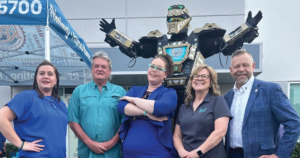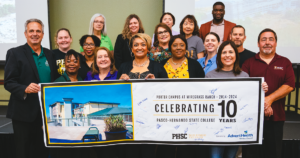By Matt Wiley
The world is getting warmer, but is the climate really changing? Is this possible change mankind’s fault? Do we have enough fresh water to keep using at the rate that we do? How high will sea levels reach 100 years from now? Most people would just shrug their shoulders, but the United States Geological Survey (USGS) Florida Water Science Center is set on finding the answers to these questions, many of which can be discovered through research being done at the Center’s new headquarters in Wesley Chapel.
On August 22, USGS Florida Water Science Center director Rafael W. Rodriguez, a resident of the Bassett Creek community in New Tampa’s K-Bar Ranch, addressed the Greater Wesley Chapel Chamber of Commerce Economic Development Committee inside the boardroom of American Consulting Engineers, located off S.R. 56 and Cypress Ridge Blvd. in Wesley Chapel.
Rodriguez provided the committee with an overview of what exactly the Water Science Center, as part of the USGS, does on a daily basis. He also gave the committee an idea of the type of research that is moving into the community.
Originally located just north of Busch Gardens on University Center Dr. in Tampa, Rodriguez says that the Water Science Center moved north to its new facility at 4450 Pet Lane in Wesley Chapel to “get closer to the field.” He explained that Wesley Chapel’s proximity to both I-75 and I-275 and central location to several water sources, including Cypress Creek and the Hillsborough River, made it the perfect location for the new office, since the Water Science Center outgrew its old facility.
The USGS’s new 21,000 sq.-ft. facility will be home to 65-70 USGS employees made up of hydro technicians, geologists, chemists, mathematicians and a variety of other engineers and scientists in related fields. The Wesley Chapel office is one of five offices in the state of Florida
“Most people think we just make maps,” he said. “The USGS is actually the nation’s largest water, earth, bio-science—and mapping—agency.”
In addition, the agency collects, monitors, analyzes and provides scientific understanding about natural resource conditions and issues.
“We provide the science,” he said. “We leave it to the local government to make the decisions.”
Much of the research that the Water Science Center conducts is used on a national scale, although Florida’s water problems are a little different than some of the other states in the country, particularly those that have been suffering through this summer’s blistering drought.
“Florida is blessed,” he said. “Florida is like a sponge. Water flows back and forth.”
One of the largest programs that the Water Science Center conducts is the USGS Cooperative Water Program, which has been active since 1895. Through this program, the center collects data that meets local and regional informational needs. The local data is then integrated into a national database, which is important when considering where and how to build developments and bridges.
Some of this data can be found on the USGS’s website in a section called Water Watch (WaterWatch.USGS.gov). Water-measuring tools that are placed in local water sources, such as Cypress Creek and the Hillsborough River, transmit real-time data to a National Weather Service (NWS) satellite, which the NWS uses when determining flood advisories.
These tools also allow the USGS to determine how much water can be extracted from rivers and wells without damaging the local ecosystem. Some of the various measurements taken include a river’s stage (height), discharge, evapotranspiration (how much water evaporates or is absorbed by plants) and water quality parameters (pH levels, temperature, dissolved oxygen). All of this information is important for determining how a river, creek or stream fluctuates over time.
But, the USGS isn’t concerned with small intervals of time, such as the human lifespan. The goal is to learn how things change over much larger spans of time.
“We think in millions of years,” Rodriguez explained. “The earth is more than 4.5 billion years old. So, 10-15 years is a nanosecond in that time frame.”
What is the USGS measuring that such a large timeframe would be needed?
Climate Change
“Climate change is real,” he said. “It’s not science fiction. It’s there.”
Rodriguez explained that climate change is affecting the way water is extracted, even today. Some wells that are located closer to the coast are in danger of having to be moved due to saltwater intrusion as water levels slowly rise, he explained. Saltwater intrusion, he said, is when salt water begins to mix with groundwater, which is where we get much of our drinking water.
“Where fresh water ends and saltwater begins is not as clear-cut under underwater,” he explained. “There is a mixing effect.”
Rodriguez showed a diagram of how a map would change if sea levels rose just half a meter. Much of the east and western coasts of Florida would be under water. He then offered the scenario of a hurricane with an additional storm surge, which is already an issue to coastal residents whenever a tropical storm or hurricane moves into our area.
“While people are boarding up, we have to get ready to monitor the storm in the field,” he said.
For more information about the USGS, please visit USGS.gov.




No comment yet, add your voice below!